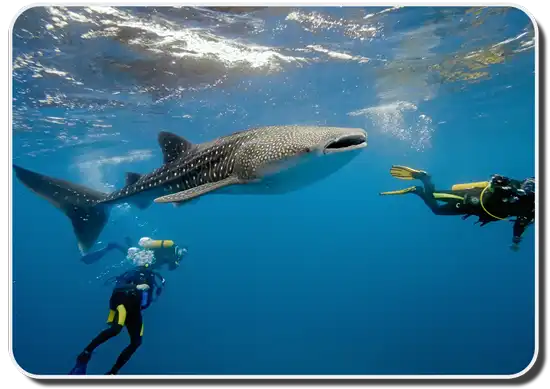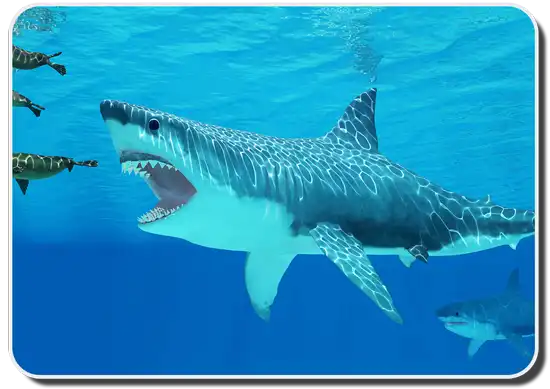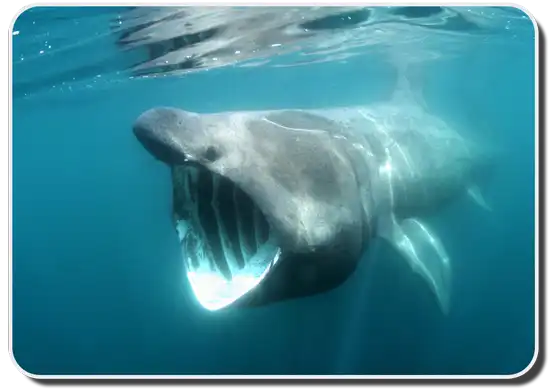We all like to imagine giant, undiscovered sharks swimming in our oceans. It’s an exciting way to have fun with our fears through fantasy. However, if there was a massive undiscovered beast swimming in our oceans, they’d have to contend with some of the biggest sharks that have already lived.

Some of these sharks are so massive, it’s hard to imagine anything growing much bigger.
Here is a rundown of the largest sharks, both extinct and still living, to ever swim in our oceans.
5 Largest Prehistoric Sharks

Cretoxyrhina
Cretoxyrhina, otherwise know as the “Ginsu Shark,” is a mass prehistoric shark that swam our oceans in the middle-late Cretaceous Period, 100-80 million years ago. The Cretoxyrhina reach a massive 25 feet (7.6m) in length and weighed between 1,000-2,000 pounds (453-907 kilos), comparable in size to the modern Great White Shark. With long sharp, knife-like teeth, the diet of the Cretoxyrhina included fish and marine animals and even dinosaurs like the Tylosaurus.
Otodus
The next massive shark on the list is the Otodus, Greek for “inclined teeth,” dominated the oceans during the Paleocene-Eocene Period, 60-45 million years ago. The Otodus grew to 30 feet (9.1m) in length and weighed 2,000-4,000 pounds (907-1814 kilos). Otodus is a direct ancestor of the massive Megalodon and had similar habits. It’s razor sharp teeth grew to 3-4 inches and it mainly feasted on whales.
Helicoprion 30 feet long (9.1m)
The Helicoprion was not only one of the most unusual prehistoric sharks but it was also one of the largest. The Helicoprion, Greek for “spiral saw”, lived during the Early Permian-Early Triassic Periods, 290-250 million years ago. Helicoprion grew to a massive 30 feet (9.1m) in length and weighed up to 1,000 pounds (453 kilos). This prehistoric shark is known for it’s unique coils of teeth that lined its jaw. These coils either unfurled or spun like a table saw to crush prey.
Ptychodus 30 feet long (9.1m)
The Ptychodus, Greek for “folded teeth,” lived during the Late Cretaceous-Early Paleogene Periods, 90-60 million years ago. This massive shark reached 30 feet (9.1m) in length and weighed between 1,000-2,000 pounds (453-907 kilos). Unlike some of the other sharks of the era, Ptychodus has large, flat teeth and was a bottom feeder that feasting on small mollusks and shellfish.
Megalodon
The last prehistoric shark, is the largest known shark to ever live, the impressive Megalodon. Greek for “big tooth,” the name Megalodon gets its name from it’s massive 7 inch (18cm) long teeth. The Megalodon reached an average of 50-78 feet (15.2 to 23.7m) in length and weighed a whopping 70-100 tons (63.5 to 90.7 metric tons). Megalodon dominated the oceans during the Cenozoic Period only 26-2.3 million years ago. Megalodon mainly ate whales, including the largest whale in history the Leviathan. This massive prehistoric creature truly inspires the imagination!
5 Largest Living Sharks

Pacific Sleeper Shark 23 feet (7m)
The Pacific Sleeper Shark is one of the largest living sharks. Swimming in the Pacific and Arctic Oceans, the Pacific Sleeper Shark reaches 23 feet (7m) in length and weighs around one ton (907 kilos). The Pacific Sleeper Shark is a deep water fish, that prefers hunting for fish, mollusks, squid, and purposes along the continental shelf.
Tiger Shark 25 feet (7.6m)
The Tiger Shark, also known as the “Sea Tiger,” lives in tropic and temperate waters around the Pacific Islands. The Tiger Shark is named for the tiger-like stripes along its back that fade as it reaches maturity. The Tiger Shark grows to a massive 25 feet (7.6m) in length and can weigh up around 1,500 pounds (1360 kilos). Tiger Sharks have a very broad diet that includes fish, mollusks, jellyfish, sea snakes, marine mammals, turtles, and even other sharks.
Great White Shark 26.2 feet (8m)
The Great White Shark is the largest of the predatory sharks in the ocean. Great White Sharks prefer the cooler waters Northeast Atlantic, Northern Pacific, and the Southern Pacific and Atlantic Oceans. The largest concentration of Great Whites is around Dyer Island in South Africa. Though size reports vary, Great White Sharks reach 26.2 feet (8m) in length and can weigh around a ton (907 kilos). Great White Sharks are impressive hunters that mainly eat fish, marine mammals, and seabirds.
Basking Shark 40 feet long (12.2m)
Though not as exciting to imagine as the fearsome Megalodon, the largest sharks that alive today are actually filter feeders like the Basking Shark. The Basking Shark prefers temperate waters in both the Northern and Southern Hemisphere, and migrates to eat plankton. The Basking Shark grows up to 40 feet (12.2m) in length and can weigh up to 19 tons (17.23 metric tons). The Basking Shark is a passive feeder and takes in plankton as it cruises slowly through the oceans.
Whale Shark 41.5 feet (12.6m)
Finally, the largest living shark is the Whale Shark, named for it’s whale size and shape. Whale Sharks live around the tropical waters around the equator. Whale Sharks reach a massive 41.5 feet (12.6m) in length and can weigh around 33,000 pounds (15,000 kilos). Whale Sharks are ram filter feeders that live off of plankton. Occasionally though, a Whale Shark will supplement its diet with small fishes.
So whether or not there’s still a massive undiscovered shark lurking in our oceans, we already have so many known sharks to capture our imagination. From the prehistoric beasts like Helicoprion and Megalodon to massive Great White and Whale Sharks, there are several large sharks that have dominated our seas throughout history. These sharks are incredible wonders of nature and can be really fun to think about!
